
Related
Topics
Closing arguments begin today in the Diallo murder trail. Four New York police officers, Richard Murphy, Sean Carroll, Edward McMellon and Kenneth Boss are charged with second degree murder for shooting Amadou Diallo to death on February 4, 1999. Diallo died in a hail of 41 bullets, having been hit 19 times. The officers are white. Diallo was black. We go live to the trial in Albany, New York, where the first defense lawyer is beginning his closing arguments. James Culleton is the defense attorney for Richard Murphy. Murphy shot four bullets at Diallo. [includes rush transcript]
Tape:
- Excerpts from closing arguments in the Diallo murder trial.
Transcript
AMY GOODMAN: We go live to the Albany trial, where the defense has begun their closing arguments in the case of the four white police officers charged with second-degree murder in the killing of Amadou Diallo last February 4th, 1999.
JAMES CULLETON: I thank you on behalf of myself. I thank you on behalf of my client, Richard Murphy.
There are certain rules that we play by. And what I’d really like to do is to sit down with you people up in the jury room and answer your questions. If you have a problem, you can question me and I could answer you. But I just can’t do that. That’s not the way — that’s not the way it works. So I have to anticipate what I feel may be some issues that you’re concerned with.
Once I sit down, I cannot get back up again to answer the arguments made by Mr. Warner in his summation. So, therefore, I’m going to have to anticipate some of his arguments. And I may not anticipate all of them. So what I’m going to ask each of you to do when you’re upstairs in the jury room to take my position. If a juror, while you’re talking about the case, raises an argument made by Mr. Warner in his summation, I would ask you other jurors to say how I would answer that particular argument. Take my position.
Now, let me begin but borrowing a few words from Mr. Warner’s opening statement and then add in some additional words that he did not mention to you in his opening. In the 1990s in Bronx County, in Albany County and everywhere else in the United States, a police officer has and has the authority — has the authority to approach a person in public who is acting suspiciously to ask him “Who are you?” and “What are you doing?”
On February 4th, 1999 at 12:40 a.m. in the morning at 1157 Wheeler Avenue in Bronx County, this simple stop to inquire, performed hundreds of thousands of times in the Bronx, in Albany and anywhere else in the United States, escalated to a point that resulted in the tragic death of Amadou Diallo.
Now, ladies and gentlemen, why Mr. Diallo acted the way he did to this simple request to talk, we’ll never know. But there are certain facts that came out during the course of this trial that we do know. We know that Mr. Diallo came home from work on February 3rd, sometime around midnight, just before midnight. We know that he had every intention of leaving his apartment after he came home. [Inaudible] testified that while he was sitting on the couch watching television, he left his coat and hat on.
We also know from the testimony of — from Luis Agosto, who you learned during this trial lives at — lived at 1148 Wheeler Avenue, across the street, that he was parking his car, his company truck, on the same side of the street where Mr. Diallo lived, a little closer to Westchester Avenue, under the lamppost. In fact, one of the photographs that are in evidence, he pointed to his truck and said, “That’s my truck.”
And we know through his testimony that fifteen to twenty minutes before this shooting, he observed Amadou Diallo standing and leaning up against the wall of 1157 Wheeler Avenue on the stoop, peering out periodically, looking up and down the street, mostly towards Westchester Avenue. He watched him. He told you from his vantage point he was able to observe that Mr. Diallo was a black man, that he was wearing dark clothes and that he had a wool hat on his head. He told you this, even though he said that the lighting in the vestibule was poor. He said there was some lighting, but it wasn’t bright.
We also learned during the course of this trial that the front door to 1157 Wheeler, which is usually kept shut, that night was open when Mr. Diallo was standing. We also know the light on the outside of 1157, which is usually on, that night was off, according to the landlord, Mr. Bassit. And we know that the switch that controls that light is inside the inner doorway in the hall.
Was Mr. Diallo standing out there for that period of time waiting for somebody? Perhaps. But as Mr. Warner mentioned in his opening statement, we have no quarrel with this. Mr. Diallo had an absolute right to be standing in the vestibule of his apartment building, where he lived.
But on February 4th, 1999, these four police officers, they didn’t know who Mr. Diallo was. They didn’t know that Mr. Diallo lived in that building. And they had an obligation, following proper police procedure, to stop, to walk up to Mr. Diallo and ask him, “Who are you?” and “Why are you in this area?”
Ladies and gentlemen, am I missing something? Is the prosecution actually going to argue in his summation, which basically they tried to develop during cross-examination and briefly touched on in their opening statement — are they going to argue that somehow these four police officers had no right to approach Mr. Diallo, that they should have closed their eyes and drove by, and nothing would have happened?
Well, ladies and gentlemen, these four men are police officers. They’re out there in the street showing a police presence for the purpose of protecting the whole community. They had an obligation to stop and ask, “Who are you? What are you doing here?” in this high-crime area that you learned about during the course of this trial. Mr. Diallo was alone. It was a cold night, and it was 12:40 a.m. in the morning. Would you — would any of you — expect any police officer in the Bronx, in Albany or anywhere else in the United States to do anything less?
If the prosecution stands up and makes this argument, that they had no right to approach Mr. Diallo, I will remind you at this time of the testimony of James Fyfe, Professor Fyfe, who told you about proper police procedure. And Mr. Fyfe told you that these officers did absolutely nothing wrong stopping the car, exiting the car to inquire, to find out who this man was and why he was standing there. And they had an absolute right to try to close this gap, following proper police procedures when this incident escalated for reasons we will never know. More importantly, ladies and gentlemen, I would ask you to listen to the judge’s charge at the end of this case concerning proper conduct by police in street encounters.
I submit to you, ladies and gentlemen, that if you analyze this case and if you listen to the testimony, the police officers did nothing wrong in stopping their vehicle that night. This case is really about what happened after they got out of the vehicle. It’s about an incident that escalated and resulted in a tragedy in a few seconds.
Now, I submit that during the course of this trial we learned something was very troublesome. In March of 1999, a grand jury in Bronx County, hearing evidence in a case of this magnitude, considering evidence against these four police officers, they listened to testimony, and based upon the testimony that they heard, they returned a verdict — or not a verdict, an indictment, against these four police officers charging them with murder in the shooting death of Amadou Diallo. Under our penal law in New York State, there is no more serious crime than murder. In 1999 in Bronx County, in Albany County and everywhere else in the United States, you would expect and demand, I submit to you, a fair presentation of evidence in a case of this magnitude and importance.
UNIDENTIFIED: Objection.
JUDGE JOSEPH TERESI: Overruled.
JAMES CULLETON: It’s not a game ladies and gentlemen. People’s lives are at stake.
AMY GOODMAN: This is defense attorney James Culleton, the attorney for Richard Murphy.
JAMES CULLETON: What we learned during the course of this trial was a woman by the name of Schrrie Elliott the defense had to call, the only eyewitness to this shooting other than the four police officers that we called to the witness stand — we learned that on March 15, 1999, she went down to the United States Attorney’s office for the Southern District of New York in Manhattan, accompanied by her two lawyers. There, she was interviewed by two assistant district attorneys from Bronx County, two assistant United States attorneys, federal prosecutors, and an FBI agent. And we learned during the course of this — that interview on March 15, 1999, Schrrie Elliott told that audience, and this was reduced to an FBI report, unequivocally, that she heard one of the police officers yell “Gun!” before the shooting started. That testimony, that statement, corroborated the testimony that you heard in this case from Officer Carroll, Officer McMellon, and my client Officer Richard Murphy.
UNIDENTIFIED: Your Honor, I object to testimony [inaudible].
JUDGE JOSEPH TERESI: Sustained. Mr. Culleton, confine your statements to the evidence in this case. Don’t charge the jury on the law.
JAMES CULLETON: Yes, Your Honor.
What happened next? Seven days later, on March 22, 1999, Schrrie Elliott testified in grand jury, Bronx County — now, she was brought back to the witness stand in this case a second time. And when she was —- when she was brought back, I asked her, “Did they ask you in the grand jury, when you testified seven days later” -—
UNIDENTIFIED: Same objection.
JUDGE JOSEPH TERESI: Overruled.
JAMES CULLETON: “Did you know who said the word 'gun'? Can you tell us that?” And we read her grand jury minutes, and the answer was, “No.” I then asked her, “Weren’t you being questioned by the same assistant district attorney who was present seven days earlier when you gave the statement that it was one of the officers who said 'gun' before the shooting started?” She said, “Yes, it was the same man.” “Well, did he ask you about that?” And what was her response? “Never asked me.” Grand jury didn’t hear that testimony. Why? Is that fair, ladies and gentlemen? Are we here to seek justice, or are we playing games?
I submit to you that the prosecution in this case, by not calling that witness, felt safe. They didn’t think we could cross-examine her. They didn’t think we’d get her FBI report where she made that statement. But they were wrong.
Ladies and gentlemen, as I said before, doesn’t it seem strange that the only eyewitness to this shooting, other than the four police officers, was called to the witness stand by the defense? Why was that? Why do you think that was? Do you think it was because they didn’t want that statement to come out? Probably. They didn’t want you to learn about that. But more importantly, and there’s a larger reason, a more important reason, a more significant reason, I submit to you why that woman wasn’t called as a prosecution witness in the case, and that’s because she destroys the very foundation of the DA’s case against these four police officers.
Make no mistake about it, ladies and gentlemen, the centerpiece of the prosecution’s case against my client and the other three police officers was the testimony of Dr. Joseph Cohen, the medical examiner.
Mr. Warner, in his opening statement, told you — you know, during jury selection, you heard something about justification, the defense of justification. But “We are going to prove during the course of this trial, beyond a reasonable doubt, that there was no justification in this case.” That was what he said in his opening. Now, how is he going to do that? Well I submit to you, ladies and gentlemen, that he was going to do that by using the centerpiece of his case, Dr. Joseph Cohen, the medical examiner.
Dr. Cohen had a theory. Bullet wound A, which he designated as A, which he told you was shot at Mr. Diallo from someone facing directly at him, bullet wound A entered the front of his chest and traveled front-to-back without any deviation to the right or to the left. And it traveled slightly upward. And I asked him on cross examination, “Was that consistent with someone firing a gun from the sidewalk in front of 1157, facing Mr. Diallo face on, with respect to the trajectory of that wound?” And he said, “Yes.”
He bases his theory — he tells you this bullet wound A happened early on. It was probably one of the first, if not the first, shot that struck Mr. Diallo during this incident. He told you that he was standing and that Mr. Diallo was standing when he received this wound, and that the bullet perforated his spinal cord. And he told you what would happen when that occurred. Mr. Diallo would instantly suffer paraplegia. His legs would not work. He would have no resistance to gravity, and within a second or two seconds, he would crumble.
AMY GOODMAN: You’re listening to Defense Attorney James Culleton, the attorney for Richard Murphy. He is the first of the attorneys to present the closing arguments in the case of the four police officers — Murphy, along with Kenneth Boss, Sean Carroll and Edward McMellon — who have been charged with second-degree murder and other charges in the killing of Amadou Diallo, who died in a hail of forty-one police bullets on February 4th, 1999. We’ll come back to the courtroom and the closing arguments in just a minute here on Pacifica Radio’s Democracy Now!
[break]
AMY GOODMAN: You’re listening to Pacifica Radio’s Democracy Now! We’re live at the trial in Albany, New York, of the four white police officers charged with second-degree murder for the killing of Amadou Diallo last February 4th, 1999. The first of the defense attorneys are presenting the closing arguments. This is defense attorney James Culleton.
JAMES CULLETON: ....your opinion. You learned that he never saw the grand jury testimony of Schrrie Elliott, nor the FBI report. He has no idea what Schrrie Elliot said. And she, I submit to you, ladies and gentlemen, destroys his theory.
Now, here’s the problem. Look at the diagram. If Mr. Diallo was struck with bullet wound A early on, first or one of the first bullets, and goes down right away and ends up as depicted in that photograph, that diagram, how does he sustain — put up the — all the wounds [inaudible]? In that diagram, his left side is not presenting itself to people on the sidewalk or on the stoop or on the steps, so that he could receive all of those bullets to the left side. He has paraplegia, receives hit A, goes down, loses all resistance to gravity, how could this be? How could he receive the wounds to the left side? The truth of the matter is, ladies and gentlemen, he can’t support his theory. He’s trying to fit a square peg in a round hole. He’s a desperate man.
He’s thought about it, his words — this is what he said on — during the course of his testimony, “hundreds of hours I thought about this.” In the luxury of his laboratory, hundreds of hours. And these four police officers had a split second to make a life-and-death situation. And he can’t come up with a theory.
And you remember his cross-examination. We pushed him, tell us — the prosecution has the burden of proof, tell us what your theory is? How could he sustain all the shots to the left side if wound A was the first one and he goes down in an instant, loses all resistance to gravity, while kicking and screaming?
Dr. Cohen gave you three scenarios. Let’s go over those scenarios. This is how he’s going to explain the wounds to the left side using his blood theory and bullet wound A having to be — being the last wound. Number one — zoom in on that, please, just — right, that’s good. Number one, the shooter or shooters would have to be standing in the vestibule. As we look at the diagram to the left of Mr. Diallo, probably in the inside door lying on the ground, shooting or shooting as he’s on his way down. Dr. Cohen doesn’t even accept that one. He even said that at one point, that probably didn’t happen. And we know from the witnesses, especially Schrrie Elliott, who watched the whole shooting, that no one during the course of the shooting was in that hallway during the shooting where they would have to be to cause all of those wounds to the left side.
Second theory: somebody moved the body. This would have had to be, not just a small move — this would have had to be a complete turnaround. In other words, the head would have to be, as we’re looking at the diagram, in the left corner with the feet facing the right corner, as opposed to the way it is now, because that way the left side is exposed to the shooters on the street. And as he’s going down or on his way down, he could have received all of those bullets to the left side, those shots.
At one point during his cross-examination, he actually tells you, “I believe the body was moved.” Ladies and gentlemen, do you think that these four police officers were so sophisticated — and you heard Lieutenant Campo, he was on the scene in forty-five seconds — do you think in forty-five seconds they would have had the wherewithal to say, “Hey, this is what we have to do to cover this up. We have to turn the body around so that the head is facing the other direction, because he received all of these bullets to the left side”?
But going beyond that, to show how ridiculous that would be, they would have to know that there was a hole in the aorta, they would have to know that the spinal cord was severed, they would have to know his blood theory. Come on, ladies and gentlemen, the witnesses told you, everyone that testified in this case that made observations either at their window — and Schrrie Elliott told you — no one moved the body. That’s exactly the way the man went down. Where he is on that diagram and in photos that are in evidence, that’s where he ended up.
His third theory, and this is the most likely theory, he says, 'cause he's been thinking about this for a hundred hours in his laboratory. Hundreds of hours. Well, he received wound A first, or one of the initial shots, as he was facing out to the street. He was turning in a clockwise direction after receiving wound A to present his left side to the shooters. And then somehow he had to turn back so he could fall down and be situated as depicted in that diagram.
Couple of problems with that. How does he turn himself around when he has paraplegia, when his legs are not working? And we learned during the course of this trial, and Dr. Cohen admitted on the witness stand, that bullets do not turn people. So what does Dr. Cohen do? Well, he said he was probably starting to turn as he received bullet wound A, and the momentum caused him to turn all the way. But he has him turning, ladies and gentlemen, in a clockwise direction. And that, I submit to you, is why they could not call Schrrie Elliott to the witness stand, because she destroys that theory. Schrrie Elliott, when she was brought back the second day, and we were allowed to cross-examine her using the grand jury minutes, she testified back on March 22, 1999, that she saw Mr. Diallo turning in a counterclockwise direction. The first part of his body that faced the shooters was his left side.
Dr. Mason, our forensic pathologist, has told you that the most likely scenario in this case was that Mr. Diallo turned counterclockwise, exposing his left side to people shooting out from the sidewalk and then turning around and receiving bullet wound A as he was on his way down. Dr. Fackler said the same thing. And Dr. Mason went on to say that bullet wound A was at the end. And I submit to you, ladies and gentlemen, that makes more sense.
That’s why they couldn’t embrace Schrrie Elliott. That’s why they didn’t call Schrrie Elliott. They felt safe. They didn’t think we could cross-examine her. They didn’t think we could bring her back and use her grand jury minutes. And when we did, that destroyed their case. Once again, they were wrong. Once again, I ask you, is that fair? Are we here to see justice served, or are we playing games?
Dr. Fackler told you that the blood theory of Dr. Cohen is incorrect, because what Dr. Cohen did not consider in formulating this theory, besides not looking at any of the photos or diagrams so he could investigate and see if it fits in and he doesn’t have to put this square peg into the round hole, Dr. Fackler told you that because of the amount of time, the quickness of this incident — and he talked about the spigot being turned on and off — he would not expect to see a lot of blood in the wounds. In fact, the amount of blood in the wounds, as evidenced by the autopsy report, is exactly what he would have expected in this particular case.
And you learned a lot through Dr. Fackler. He told you about the entertainment media. We’re conditioned by the movies and by television, but in reality people are not knocked over by bullets. Blood doesn’t come spurting out when someone is shot. He told you that full metal, copper-jacketed bullets, the type used in this particular case, they don’t have any stopping power. And it’s not inconsistent, unless, of course, the spinal cord is hit or a bone supported — a bone in the leg, which supports a person’s weight, if that happens initially. You wouldn’t have any reaction. The person who’s shooting wouldn’t see any reaction from the person who was shot. And that is exactly what these police officers told you when they testified in this case.
Well, they don’t have Dr. Cohen, so Mr. Warner in his summation may say, “Well, wait. What about this pause that we brought up in the beginning of the trial?” Ladies and gentlemen, a pause. Was there a pause in this case? Was there an insignificant break that some witnesses who were called who lived across the street —
UNIDENTIFIED: [Inaudible]
JAMES CULLETON: — some people didn’t even hear it. Other people, and they gave you demonstrations — and I’ll leave it to your recollection — I mean, it was a second or less. A pause, the argument will be made, is that someone has a time to reflect, to look and say — say they’re in a room and they see something — “Wait a minute. That’s not a gun.” That’s why you heard that type of testimony. But we’re not talking about a significant pause here, if one existed at all. And based upon the facts that you’ve heard described by the police officers, no one had time to reflect during the course of this case. One man was falling off the stairs, apparently shot to the people behind him and Officer Carroll, and Officer Carroll was scrambling down the stairs. No one was looking — “Do we have time to reflect?”
The only witness, ladies and gentlemen, who came in here and talked about a pause was an individual by the name of Thomas Bell. Despite everyone’s testimony that lived across the street, that we called, that the prosecution called, or on the same side of the street as Mr. Diallo, Mr. Bell, who lives — and you can look at this diagram, it’s in evidence — two football fields down the block, 588 feet — zero in on the top part, please — he then has to walked seventy feet, two inches, to his vestibule, walk another thirty-nine feet, one inch, to go into his building. He lives on the fourth floor. His windows face Watson Avenue. A short block away is Bruckner Boulevard, a busy highway in Bronx County, where trucks go by day in and day out. He’s on the phone talking with somebody, and he has a phone that he puts over his ears. It’s a headset, at least one ear — I don’t recollect his testimony, but at least one ear. He’s talking on the phone when he hears this. He has no idea how long the initial shots before the pause lasted or how long the shots lasted after the pause.
AMY GOODMAN: This is James Culleton, defense attorney in the beginning of the closing arguments of the Amadou Diallo murder trial.
And I’m going to end today’s programs with the words of one of the editors of Newsday, who wrote a column on Sunday, Les Payne. He said, “Amadou Diallo was hit with nineteen bullets more last week, as his body, troubled still, lay cold in a village plot a stormy ocean away. One thinks of the ghost of Hamlet’s father haunting the ramparts of Elsinore Castle in search of a tongue to bear true witness to his bloody demise.
“Upon spotting the diaphanous king, in Shakespeare’s opening scene of Hamlet, Horatio ponders the deeds that rushed the king to an early grave. 'If thou hath any sound or use of voice,' Horatio implores the ghost, 'speak to me.' Alas, no one speaks for poor Amadou. There is no Horatio, no Marcello, indeed no Shakespeare to walk Diallo’s spirits in the night.
“After Diallo pulled out his wallet, four killer cops gunned him down on the steps of his apartment, firing forty-one bullets, nineteen of them doing their deadly duty. After months of washing and ironing their story in the laundry of their lawyers, the four cops brought their case to a friendly Albany courtroom, 149 miles from the Bronx killing ground.”
That does it for today’s program, as we’ve been bringing you live coverage from the Albany courtroom where the four officers are on trial for second-degree murder in the death of Amadou Diallo. Also, thanks to Court TV for making this possible.

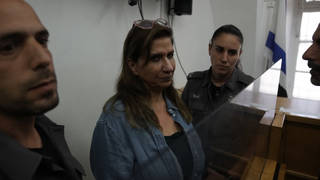
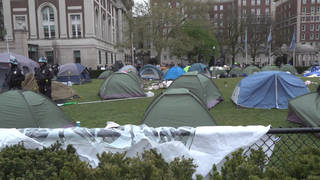
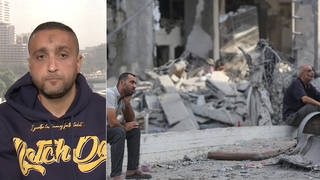
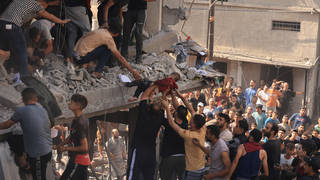





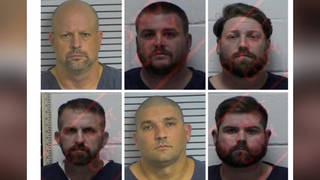

Media Options